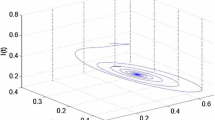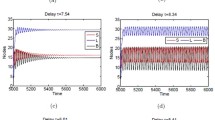Abstract
The vulnerability that exists in the computer network by the infection of virus as soon as the resources are exposed requires the study of the nature of propagation of virus into the network. In this work we have formulated a novel epidemic Susceptible-Infected-Recovered model that deals with the infected nodes in the network in terms of the development of immunity attained after recovery. Positivity and boundedness of the proposed model is examined. Local stability analysis of the proposed model without delay is also analyzed by Routh–Hurwitz criteria apart from the delay sensitivity analysis. The time series analysis regarding the nature of the susceptible, infected and recovered nodes in the network has been performed using real control parameters \(\beta\) (infection rate of the computers), \(\gamma\) (recovered rate of the infected computers). We also analyzed that time delay may play significant role on the stability of the proposed model since whenever delay exceeds the critical value the system loses its stability and a Hopf bifurcation occurs. The numerical simulation results justify that the proposed model is validated against the analytical studies of virus propagation thus verifying the theoretical results.




Similar content being viewed by others
References
Nwokoye, Chukwu Nonso, & Umeh, Ikechukwu. (2018). Analytic-agent cyber dynamical systems analysis and design method for modeling spatio-temporal factors of malware propagation in wireless sensor networks. MethodsX, 5, 1373–1398. https://doi.org/10.1016/j.mex.2018.10.005.
Zhang, T., Yang, L. X., Yang, X., Wu, Y., & Tang, Y. Y. (2017). Dynamic malware containment under an epidemic model with alert. Physica A: Statistical Mechanics and its Applications, 470, 249–260.
Peng, Mei, He, Xing, Huang, Junjian, & Dong, Tao. (2013). Modeling computer virus and its dynamics. Mathematical Problems in Engineering. https://doi.org/10.1155/2013/842614.
Zhu, Qingyi, & Cen, Chen. (2017). A novel computer virus propagation model under security classification. Discrete Dynamics in Nature and Society, 83, 1–11. https://doi.org/10.1155/2017/8609082.
Upadhyay, R. K., & Kumari, S. (2018). Bifurcation analysis of an e-epidemic model in wireless sensor network. International Journal of Computer Mathematics, 95(9), 1775–1805. https://doi.org/10.1080/00207160.2017.1336550.
Zhang, Z., Kundu, S., & Wei, R. (2019). A delayed epidemic model for propagation of malicious codes in wireless sensor network. Mathematics, 7(5), 396. https://doi.org/10.3390/math7050396.
Tian-Mu, C., Jia, R., Qiu-Peng, W., Ze-Yu, Z., Jing-An, C., & Ling, Y. (2020). A mathematical model for simulating the phase-based transmissibility of a novel coronavirus. Infectious Diseases of Poverty, 9, 24. https://doi.org/10.1186/s40249-020-00640-3.
Zizhen, Z., & Huizhong, Y. (2013). Stability and Hopf bifurcation in a delayed SEIRS worm model in computer network. Mathematical Problems in Engineering. https://doi.org/10.1155/2013/319174.
Zhao, Tao, & Bi, Dianjie. (2017). Hopf bifurcation of a computer virus spreading model in the network with limited anti-virus ability. Advances in Difference Equations. https://doi.org/10.1186/s13662-017-1243-x.
Murray, W. H. (1998). The application of epidemiology to computer viruses. Computers & Security, 7(2), 130–150. https://doi.org/10.1016/0167-4048(88)90327-6.
Billings, L., Spears, W. M., & Schwartz, I. B. (2002). A unified prediction of computer virus spread in connected networks. Physics Letters A, 297(3–4), 261–266. https://doi.org/10.1016/S0375-9601(02)00152-4.
Ren, J., Yang, X., Zhu, Q., Yang, L. X., & Zhang, C. (2012). A novel computer virus model and its dynamics. Nonlinear Analysis: Real World Applications, 13(1), 376–384. https://doi.org/10.1016/j.nonrwa.2011.07.048.
Zhu, Q., Yang, X., & Ren, J. (2012). Modeling and analysis of the spread of computer virus. Communications in Nonlinear Science and Numerical Simulation, 17(12), 5117–5124. https://doi.org/10.1016/j.cnsns.2012.05.030.
Lijuan, C., & Jitao, S. (2014). Global stability and optimal control of an SIRS epidemic model on hetergeneous networks. Physica A, 4(10), 196–204. https://doi.org/10.1016/j.physa.2014.05.034.
Ren, J., Yang, X., Yang, L.-X., Xu, Y., & Yang, F. (2012). A delayed computer virus propagation model and its dynamics. Chaos, Solitons & Fractals, 45(1), 74–79. https://doi.org/10.1016/j.chaos.2011.10.003.
Feng, L., Liao, X., Li, H., & Han, Q. (2012). Hopf bifurcation analysis of a delayed viral infection model in computer networks. Mathematical and Computer Modelling, 56(7–8), 167–179. https://doi.org/10.1016/j.mcm.2011.12.010.
Zhu, Q., Yang, X., Yang, L.-X., & Zhang, C. (2012). Optimal control of computer virus under a delayed model. Applied Mathematics and Computation, 218(23), 11613–11619. https://doi.org/10.1016/j.amc.2012.04.092.
Gan, C., Yang, X., Liu, W., Zhu, Q., & Zhang, X. (2012). Propagation of computer virus under human intervention: A dynamical model. Discret: Discrete Dynamics in Nature and Society. https://doi.org/10.1155/2012/106950.
Gan, C., Yang, X., Liu, W., Zhu, Q., & Zhang, X. (2013). An epidemic model of computer viruses with vaccination and generalized nonlinear incidence rate. Applied Math and Computation, 222(1), 265–274. https://doi.org/10.1016/j.amc.2013.07.055.
Gan, C., Yang, X., Liu, W., & Zhu, Q. (2014). A propagation model of computer viruswith nonlinear vaccination probability. Communications in Nonlinear Science and Numerical Simulation, 19(1), 92–100. https://doi.org/10.1016/j.cnsns.2013.06.018.
Gan, C., Yang, X., & Zhu, Q. (2014). Global stability of a computer virus propagation model with two kinds of generic nonlinear probabilities. Abstract and Applied Analysis. https://doi.org/10.1155/2014/735327.
Zhao, T., Zhang, Z., & Upadhyay, R. K. (2018). Delay-induced Hopf bifurcation of an SVEIR computer virus model with nonlinear incidence rate. Advances in Difference Equations. https://doi.org/10.1186/s13662-018-1698-4.
Upadhyay, R. K., Kumari, S., & Misra, A. K. (2017). Modeling the virus dynamics in computer network with SVEIR model and nonlinear incident rate. Journal of Applied Mathematics and Computing, 54(1), 485–509. https://doi.org/10.1007/s12190-016-1020-0.
Mishra, B. K., & Saini, D. K. (2010). SEIQRS model for the transmission of malicious objects in computer network. Applied Mathematical Modelling, 34(3), 710–715. https://doi.org/10.1016/j.apm.2009.06.011.
Nwokoye, C. H., & Umeh, I. I. (2017). The SEIQR–V model: On a more accurate analytical characterization of malicious threat defense. International Journal of Information Technology and Computer Science, 9(12), 28–37. https://doi.org/10.5815/ijitcs.2017.12.04.
Chunlei, W., & Shouxia, C. (2016). Hopf bifurcation of an SEIRS epidemic model with delays and vertical transmission in the network. Advances in Difference Equations. https://doi.org/10.1186/s13662-016-0793-7.
Kumar Nilam, A. (2018). Stability of a time delayed SIR epidemic model along with nonlinear incidence rate and holling type-II treatment rate. International Journal of Computational Methods. https://doi.org/10.1142/S021987621850055X.
Author information
Authors and Affiliations
Corresponding author
Additional information
Publisher's Note
Springer Nature remains neutral with regard to jurisdictional claims in published maps and institutional affiliations.
Rights and permissions
About this article
Cite this article
MadhuSudanan, V., Geetha, R. Dynamics of Epidemic Computer Virus Spreading Model with Delays. Wireless Pers Commun 115, 2047–2061 (2020). https://doi.org/10.1007/s11277-020-07668-6
Published:
Issue Date:
DOI: https://doi.org/10.1007/s11277-020-07668-6




